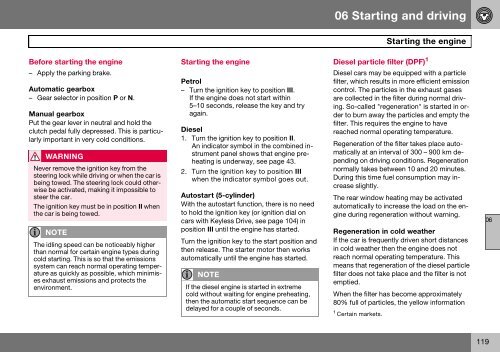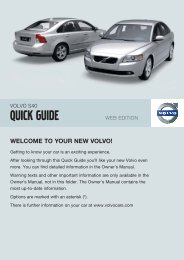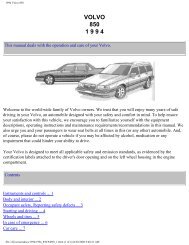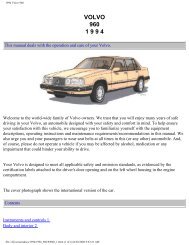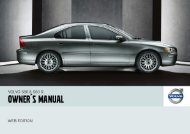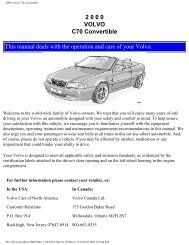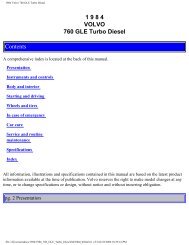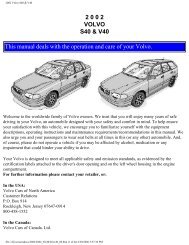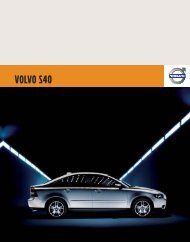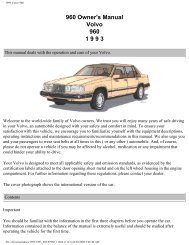V50 w646.book - ESD - Volvo
V50 w646.book - ESD - Volvo
V50 w646.book - ESD - Volvo
You also want an ePaper? Increase the reach of your titles
YUMPU automatically turns print PDFs into web optimized ePapers that Google loves.
06 Starting and driving<br />
Starting the engine<br />
Before starting the engine<br />
Starting the engine<br />
Diesel particle filter (DPF) 1<br />
Diesel cars may be equipped with a particle<br />
filter, which results in more efficient emission<br />
control. The particles in the exhaust gases<br />
are collected in the filter during normal driving.<br />
So-called "regeneration" is started in order<br />
to burn away the particles and empty the<br />
filter. This requires the engine to have<br />
reached normal operating temperature.<br />
Regeneration of the filter takes place automatically<br />
at an interval of 300 – 900 km depending<br />
on driving conditions. Regeneration<br />
normally takes between 10 and 20 minutes.<br />
During this time fuel consumption may increase<br />
slightly.<br />
The rear window heating may be activated<br />
automatically to increase the load on the engine<br />
during regeneration without warning.<br />
– Apply the parking brake.<br />
Automatic gearbox<br />
– Gear selector in position P or N.<br />
Manual gearbox<br />
Put the gear lever in neutral and hold the<br />
clutch pedal fully depressed. This is particularly<br />
important in very cold conditions.<br />
WARNING<br />
Never remove the ignition key from the<br />
steering lock while driving or when the car is<br />
being towed. The steering lock could otherwise<br />
be activated, making it impossible to<br />
steer the car.<br />
The ignition key must be in position II when<br />
the car is being towed.<br />
NOTE<br />
The idling speed can be noticeably higher<br />
than normal for certain engine types during<br />
cold starting. This is so that the emissions<br />
system can reach normal operating temperature<br />
as quickly as possible, which minimises<br />
exhaust emissions and protects the<br />
environment.<br />
Petrol<br />
– Turn the ignition key to position III.<br />
If the engine does not start within<br />
5–10 seconds, release the key and try<br />
again.<br />
Diesel<br />
1. Turn the ignition key to position II.<br />
An indicator symbol in the combined instrument<br />
panel shows that engine preheating<br />
is underway, see page 43.<br />
2. Turn the ignition key to position III<br />
when the indicator symbol goes out.<br />
Autostart (5-cylinder)<br />
With the autostart function, there is no need<br />
to hold the ignition key (or ignition dial on<br />
cars with Keyless Drive, see page 104) in<br />
position III until the engine has started.<br />
Turn the ignition key to the start position and<br />
then release. The starter motor then works<br />
automatically until the engine has started.<br />
NOTE<br />
If the diesel engine is started in extreme<br />
cold without waiting for engine preheating,<br />
then the automatic start sequence can be<br />
delayed for a couple of seconds.<br />
Regeneration in cold weather<br />
If the car is frequently driven short distances<br />
in cold weather then the engine does not<br />
reach normal operating temperature. This<br />
means that regeneration of the diesel particle<br />
filter does not take place and the filter is not<br />
emptied.<br />
When the filter has become approximately<br />
80% full of particles, the yellow information<br />
1 Certain markets.<br />
06<br />
119


